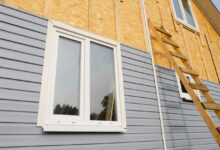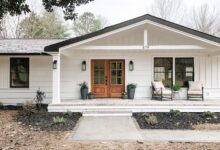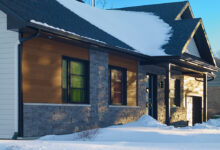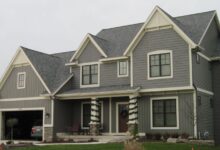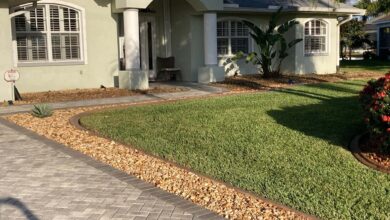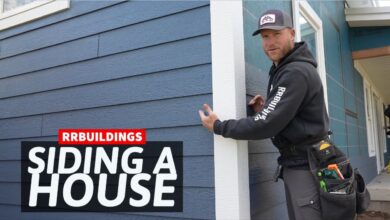Vinyl vs. Wood Siding: Pros, Cons, and Cost
Vinyl vs. Wood Siding: Pros, Cons, and Cost Comparison. Choosing the right siding for your home is a significant decision, impacting both aesthetics and long-term costs. This comprehensive guide delves into the key differences between vinyl and wood siding, examining durability, maintenance, design options, environmental impact, installation processes, and, crucially, the cost implications of each. We’ll equip you with the knowledge to make an informed choice that best suits your needs and budget.
This comparison explores the advantages and disadvantages of each material, considering factors like lifespan, maintenance requirements, aesthetic versatility, and environmental impact. We’ll also provide a detailed cost breakdown, including material costs, labor, and potential long-term expenses, helping you understand the true value proposition of each siding option. By the end, you’ll be well-prepared to select the siding that perfectly complements your home and lifestyle.
Vinyl vs. Wood Siding
Choosing the right siding for your home is a significant decision, impacting both aesthetics and long-term costs. This section compares vinyl and wood siding, two popular options, considering their material properties, visual appeal, and cost implications. Wood siding, a classic choice, offers a natural, varied look, while vinyl siding provides a low-maintenance, durable alternative. However, each material has distinct advantages and disadvantages that should be carefully weighed.
Wood siding, typically made from cedar, redwood, or pine, provides a timeless and aesthetically pleasing exterior. Its natural texture and variations in color create a unique look. However, wood requires more maintenance, including regular painting or staining to protect against rot, insect damage, and weathering. Vinyl siding, conversely, is manufactured from PVC plastic, offering a smooth, consistent finish in a wide range of colors and styles. It is highly resistant to moisture, insects, and rot, demanding minimal upkeep. While vinyl can mimic the look of wood, it lacks the inherent texture and natural variation of its wood counterpart.
Cost Comparison of Vinyl and Wood Siding
The initial cost of siding installation is a crucial factor in the decision-making process. The following table provides estimated costs per square foot for both vinyl and wood siding, encompassing material and installation expenses. Note that these figures are averages and can vary significantly based on factors such as location, labor costs, siding quality, and project complexity. For instance, intricate designs or large areas will increase the overall cost. Furthermore, regional variations in material availability and labor rates will also affect the final price. Premium wood types like cedar will command higher prices than standard pine.
| Material | Material Cost ($/sq ft) | Installation Cost ($/sq ft) | Total Cost ($/sq ft) |
|---|---|---|---|
| Vinyl Siding | $2 – $5 | $3 – $6 | $5 – $11 |
| Wood Siding | $6 – $15 | $4 – $8 | $10 – $23 |
Durability and Lifespan
Choosing between vinyl and wood siding involves considering their respective lifespans and how well they withstand various weather conditions. Both materials offer distinct advantages and disadvantages in terms of longevity and maintenance needs. Understanding these differences is crucial for making an informed decision that aligns with your budget and long-term goals.
Vinyl siding, known for its relatively low maintenance, generally boasts a longer lifespan than many expect. Its resistance to rot, insect infestation, and warping makes it a durable choice, particularly in regions with fluctuating temperatures and high humidity. However, extreme weather events can still impact vinyl, potentially leading to cracking or discoloration over time. Conversely, wood siding, while requiring more upkeep, can last for decades with proper care and maintenance. Its natural beauty and potential for customization are significant advantages, but its susceptibility to damage from moisture, insects, and extreme temperatures necessitates regular inspections and maintenance.
Lifespan and Durability under Varying Weather Conditions
Vinyl siding typically lasts 20-50 years, depending on quality and exposure. Its resistance to moisture makes it suitable for humid climates. However, prolonged exposure to intense sunlight can lead to fading and discoloration. Extreme cold can cause it to become brittle, increasing the risk of cracking. Wood siding, when properly treated and maintained, can last 30-80 years or even longer. However, its vulnerability to moisture necessitates regular maintenance, especially in areas with high rainfall or snowfall. Extreme heat can cause wood to warp or crack, while extreme cold can lead to expansion and contraction, potentially damaging the siding over time. Proper sealing and painting can significantly extend the life of wood siding, mitigating the impact of harsh weather.
Maintenance Requirements
Vinyl siding requires minimal maintenance. Regular cleaning with water and a mild detergent is usually sufficient to remove dirt and grime. Repairs typically involve replacing individual panels, which is relatively straightforward. Wood siding, on the other hand, requires significantly more maintenance. Regular cleaning, painting or staining every few years, and occasional caulking are necessary to protect it from moisture damage. Repairs can be more complex and costly, often requiring the expertise of a professional. For both types, preventative maintenance is key to extending their lifespan.
Common Issues and Potential Failures
The following list details common problems that can occur with both vinyl and wood siding:
- Vinyl Siding: Cracking, warping, fading, discoloration, impact damage (dents).
- Wood Siding: Rot, insect infestation (termite damage, carpenter ants), warping, cracking, peeling paint, moisture damage.
Aesthetics and Design Options
Choosing between vinyl and wood siding involves careful consideration of aesthetic preferences. Both materials offer a diverse range of styles and finishes, but their visual impact and suitability differ depending on the architectural style and desired overall look. This section will explore the aesthetic qualities of each siding type and their appropriateness for various homes.
The aesthetic appeal of vinyl and wood siding stems from their distinct characteristics. Wood siding, with its natural grain and variations in color, exudes warmth and a sense of rustic charm. Vinyl, on the other hand, offers a cleaner, more uniform appearance, and can mimic the look of wood or other materials with impressive accuracy. The choice between the two ultimately depends on the homeowner’s personal style and the architectural style of the house.
Architectural Style Suitability
The best choice of siding material often depends on the architectural style of the house. Both vinyl and wood can complement various styles, but certain styles are better suited to one material over the other.
- Wood Siding: Wood siding is particularly well-suited for homes with traditional, rustic, or craftsman styles. Its natural texture and varied color tones complement the inherent warmth and character of these architectural designs. Examples include Cape Cod, Colonial, and Victorian homes. The natural variations in wood grain can add to the charm and visual interest of these styles.
- Vinyl Siding: Vinyl siding is often a popular choice for modern, contemporary, or ranch-style homes. Its clean lines and consistent appearance align well with the minimalist aesthetic of these styles. The wide range of colors and finishes available in vinyl also allows for greater design flexibility, enabling it to seamlessly integrate with various architectural themes. The low maintenance aspect is also a considerable advantage for modern lifestyles.
Color and Texture Options
Both vinyl and wood siding offer a wide variety of color and texture choices, though the ranges differ in their scope and production methods.
- Wood Siding: Wood siding’s natural color palette is limited by the type of wood used, though staining and painting significantly expand the possibilities. Textures vary depending on the wood species and the milling process, ranging from smooth to deeply textured. Popular wood siding options include cedar, redwood, and pine, each possessing a unique grain and color. The natural variations in color and texture contribute to the unique character of wood siding.
- Vinyl Siding: Vinyl siding offers a far broader range of colors and textures than wood. Manufacturers utilize advanced techniques to create vinyl siding that mimics the look of wood grain, stone, or even stucco. Colors are consistent and less prone to fading compared to painted wood. Textures can range from smooth to deeply embossed, offering a high degree of design flexibility. The ability to precisely replicate desired colors and textures makes vinyl a versatile choice.
Environmental Impact
Choosing between vinyl and wood siding involves considering not only aesthetics and cost but also the environmental implications of each material throughout its lifecycle. Both options have associated environmental impacts, ranging from manufacturing and transportation to disposal and potential recycling. A comprehensive comparison helps homeowners make informed decisions aligned with their environmental values.
The environmental impact of vinyl and wood siding differs significantly across several key areas: energy consumption during manufacturing, waste generation, carbon footprint, and recyclability. Understanding these differences is crucial for evaluating the long-term ecological consequences of each choice.
Manufacturing Processes and Energy Consumption
Vinyl siding production is an energy-intensive process. The manufacturing of polyvinyl chloride (PVC), the primary component of vinyl siding, requires substantial energy input. This energy often comes from fossil fuels, contributing to greenhouse gas emissions. In contrast, while wood siding requires energy for harvesting, milling, and transportation, the energy intensity is generally lower than that of vinyl production, particularly if sustainably harvested wood is used. Studies have shown that the embodied energy (the total energy consumed throughout the product’s lifecycle) of wood siding is often lower than that of vinyl, depending on the wood species and the distance it needs to travel. For example, locally sourced wood from sustainably managed forests will have a significantly lower embodied energy than vinyl siding shipped across continents.
Waste Generation and Disposal
Vinyl siding, being a non-biodegradable material, contributes to landfill waste. While some vinyl recycling programs exist, the recycling rate remains relatively low. The disposal of vinyl siding can also pose environmental challenges due to the potential release of harmful substances during incineration. Wood siding, while also generating waste, is generally considered more biodegradable and compostable than vinyl. However, treated lumber can contain chemicals that may leach into the soil, requiring careful disposal. Landfill space is also a factor, though wood decomposes more readily than vinyl. For example, a large-scale demolition project using vinyl siding will generate significantly more non-biodegradable waste compared to a similar project using wood siding.
Carbon Footprint
The carbon footprint of vinyl siding is considerably higher than that of wood siding, primarily due to the energy-intensive manufacturing process and the use of fossil fuels. The extraction, processing, and transportation of raw materials also contribute to the overall carbon footprint. Wood siding, especially from sustainably managed forests, can have a significantly lower carbon footprint, potentially even acting as a carbon sink if the harvested trees are replaced. The carbon footprint is also influenced by the distance the materials travel; locally sourced wood will generally have a smaller footprint than vinyl shipped internationally. Life cycle assessments regularly show this disparity.
Recyclability and Sustainability
The recyclability of vinyl siding is limited, and the recycling infrastructure is not yet fully developed in many regions. While some manufacturers offer recycling programs, the actual recycling rate remains low. Wood siding, on the other hand, can be reused, repurposed, or recycled, particularly if it’s in good condition. Sustainable forestry practices further enhance the environmental credentials of wood siding, ensuring responsible resource management and minimizing deforestation. The use of certified wood, such as FSC-certified wood, signifies adherence to responsible forestry standards, contributing to the long-term health of forests.
Cost Comparison
Choosing between vinyl and wood siding involves a significant financial commitment. Understanding the various cost components and how they can fluctuate based on several factors is crucial for making an informed decision. This section provides a detailed breakdown of the costs associated with each siding type, enabling a more accurate comparison.
The overall cost of siding installation is influenced by a multitude of factors. These include the size of the house, the complexity of the design (e.g., multiple gables, dormers, intricate trim), the geographic location (affecting labor rates and material availability), and the chosen installer’s experience and pricing structure. Furthermore, the condition of the existing siding and whether or not additional work, such as underlayment replacement or structural repairs, is needed significantly impacts the final price.
Cost Breakdown Table
| Cost Category | Vinyl Siding | Wood Siding | Notes |
|---|---|---|---|
| Material Cost | $3-$8 per square foot | $10-$30 per square foot | Prices vary greatly depending on the quality, style, and color of the siding. Premium vinyl and wood options can significantly increase costs. |
| Labor Cost | $2-$5 per square foot | $4-$10 per square foot | Labor costs are influenced by the complexity of the installation, the accessibility of the house, and regional labor rates. Wood siding generally requires more skilled labor and therefore is more expensive. |
| Permits | $100-$500 | $100-$500 | Permit costs vary widely by location and the scope of the project. Larger projects or those in areas with stricter regulations will likely have higher permit fees. |
| Additional Expenses | $500-$2000 (e.g., removal of old siding, flashing, trim) | $1000-$5000 (e.g., removal of old siding, flashing, trim, potential for more extensive repairs) | This category includes unexpected repairs, necessary underlayment replacement, and the cost of additional materials like trim, flashing, and caulking. Wood siding projects often require more extensive preparatory work. |
Factors Influencing Overall Cost
The size of the house directly correlates with material and labor costs. A larger house requires more siding and more labor hours, leading to a higher overall cost. Similarly, complex house designs with many angles, dormers, and intricate trim details will increase both material and labor costs. Labor rates are highly variable depending on geographic location and the installer’s experience. Highly skilled installers often charge more, but their expertise can result in a more efficient and higher-quality installation.
Long-Term Cost of Ownership
While initial costs are a significant factor, long-term costs associated with maintenance and repairs should also be considered. Vinyl siding generally requires minimal maintenance, limiting long-term expenses. Occasional cleaning and occasional repairs for minor damage are typically the extent of the upkeep. Wood siding, however, requires more frequent maintenance, including repainting or restaining every few years, and is more susceptible to damage from rot, insects, and weathering, necessitating more frequent and potentially costly repairs. For example, a 2,000 square foot house with wood siding might require repainting every 5-7 years at a cost of $2,000-$5,000, significantly impacting long-term ownership costs compared to low-maintenance vinyl siding.
Installation Process
The installation process for both vinyl and wood siding differs significantly, impacting both the time required and the skillset needed. Vinyl siding installation is generally considered easier for DIYers, while wood siding requires more experience and precision. Understanding these differences is crucial for budgeting time and resources for your project.
Vinyl Siding Installation
Vinyl siding installation is a relatively straightforward process, suitable for many DIY enthusiasts with basic carpentry skills. However, attention to detail is essential to ensure a weathertight and aesthetically pleasing result.
- Preparation: This crucial first step involves measuring the area to be sided, ordering the correct amount of vinyl siding and necessary accessories (J-channel, starter strips, etc.), and preparing the wall surface. This includes removing any existing siding, repairing damaged sheathing, and ensuring a level surface.
- Installation of Flashing and Water Barriers: Proper flashing and water barriers are essential to prevent water damage. This step involves installing flashing around windows and doors and applying a water-resistant membrane to the wall surface.
- Installation of Starter Strip and J-Channel: The starter strip provides a level base for the first row of siding, while the J-channel creates a neat finish around corners and windows.
- Installation of Siding Panels: Vinyl siding panels are typically overlapped and snapped into place. This process requires careful alignment and attention to ensure proper overlap and avoid gaps.
- Installation of Finishing Pieces: Once the main siding is installed, finishing pieces such as J-channel, corner trim, and soffit are added to complete the installation.
The average time for vinyl siding installation varies depending on the size of the project and the experience of the installer, but generally ranges from a few days to a couple of weeks for a typical house.
Wood Siding Installation
Wood siding installation is a more complex process requiring more advanced carpentry skills and specialized tools. Precision is paramount to ensure a long-lasting, weather-resistant installation.
- Preparation: Similar to vinyl, this includes measuring, ordering materials (wood siding, nails, flashing, etc.), and preparing the wall surface. This often involves more extensive repairs and surface preparation due to the potential for wood to warp or rot.
- Installation of Flashing and Water Barriers: This is crucial with wood siding to protect against moisture damage. A high-quality water-resistant barrier is recommended.
- Framing and Sheathing: Wood siding often requires additional framing and sheathing to create a level and stable surface for installation. This is particularly important for larger projects or areas with uneven walls.
- Installation of Wood Siding: Wood siding installation typically involves nailing the siding to the wall, ensuring proper spacing and alignment. This process requires precision and care to avoid damage to the wood.
- Caulking and Sealing: After installation, caulking and sealing are crucial to prevent water infiltration. This involves filling gaps and cracks between siding boards and around windows and doors.
- Finishing: Depending on the type of wood siding, finishing may involve staining, painting, or applying a sealant to protect the wood from the elements.
Wood siding installation generally takes longer than vinyl, often requiring several weeks or even months for larger projects, depending on the complexity and the installer’s experience. The time needed also increases significantly with more intricate designs or detailing. For example, installing a complex shake shingle siding on a large Victorian home would take considerably longer than installing simple clapboard siding on a smaller ranch-style home.
Insulation and Energy Efficiency
Choosing between vinyl and wood siding significantly impacts a home’s energy efficiency. Both materials offer varying degrees of insulation, directly affecting heating and cooling costs and the overall environmental footprint of the building. Understanding these differences is crucial for making an informed decision.
The thermal performance of siding materials is primarily determined by their R-value, a measure of thermal resistance. A higher R-value indicates better insulation, meaning less heat transfer through the material. This translates to lower energy consumption for heating and cooling. The R-value is influenced by the material’s density, thickness, and composition.
R-Value Comparison of Vinyl and Wood Siding
While the R-value of siding alone is not the sole determinant of a home’s overall energy efficiency (factors such as insulation in walls and windows also play a crucial role), it contributes significantly. Vinyl siding typically has a lower R-value than wood siding. A typical vinyl siding panel might have an R-value of around 0.5 to 0.6 per inch of thickness, whereas wood siding can offer a slightly higher R-value, depending on the type and thickness of the wood, generally ranging from 0.7 to 1.0 per inch. This difference, while seemingly small, can accumulate over the entire surface area of a house and influence energy costs over time. For instance, a house with 2000 square feet of wall space might see a noticeable difference in energy consumption based on this R-value disparity, especially in climates with extreme temperature fluctuations.
Impact on Heating and Cooling Costs
The difference in R-value translates directly into energy costs. Homes clad in wood siding, possessing a slightly higher R-value, generally require less energy to maintain a comfortable interior temperature. During winter, less heat escapes through the walls, reducing the demand on the heating system. Similarly, in summer, less heat is absorbed and transferred into the house, minimizing the load on the air conditioning system. While the exact savings vary based on factors like climate, home size, and insulation levels in other building components, studies have shown that homes with better-insulated exteriors can see reductions in energy bills of 5-15% or more compared to those with less efficient siding. For example, a homeowner in a region with harsh winters might see annual savings of several hundred dollars by choosing wood siding over vinyl.
Factors Affecting Overall Energy Efficiency Beyond Siding R-Value
It’s crucial to understand that siding’s R-value is just one piece of the energy efficiency puzzle. Other factors, such as the overall wall construction (including insulation within the walls), window efficiency, and air sealing, significantly impact a home’s energy performance. Even with higher R-value wood siding, poor insulation in the walls or leaky windows will negate much of the benefit. Therefore, a holistic approach to energy efficiency that considers all aspects of the building envelope is essential. A well-insulated home with less efficient siding may still outperform a poorly insulated home with high R-value siding.
Epilogue
Ultimately, the choice between vinyl and wood siding depends on individual priorities and circumstances. While vinyl offers affordability, low maintenance, and durability, wood provides a classic aesthetic appeal and potential for increased home value. By carefully weighing the pros and cons presented, including the detailed cost analysis and environmental considerations, homeowners can make a confident and well-informed decision that aligns with their budget, aesthetic preferences, and long-term goals. Remember to consult with a qualified contractor for personalized advice and accurate cost estimates specific to your project.

